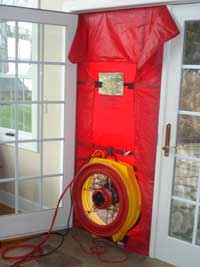An Energy Audit: The First Step Toward Home Energy Efficiency
A comprehensive, diagnostic energy audit will not only pinpoint the source of the problem but also prioritize recommended improvements to maximize the return on investment.
by Jeff Pizzino* | October 2010 | print pdf |
With the Aug. 24 launch of Tennessee's energy-efficient appliance rebate program, along with continuing concern about finding ways to reduce energy usage and overhead in these challenging economic times, more residents and businesses are becoming energy conscious. According to the U.S. Department of Energy, an energy audit is the "first step to assess how much energy your home consumes and to evaluate what measures you can take to make your home more energy efficient."
Lifelong Nashville resident Derek Pace, with more than 10 years' experience in the design, construction, and repair of homes ranging from $200,000 to more than $2,000,000, founded his Pro Energy Consultants franchise in middle Tennessee in July 2010. "No matter what the cost or age of the building or how well it was constructed, I saw firsthand the need for improved energy efficiency to lower energy costs, potentially saving the owner thousands of dollars," said Pace. "Energy costs are a monthly expense that compound over time. Any cost reduction reflects significant cumulative savings to home and light commercial office owners."
The business is the first national energy auditing franchise and has quickly grown to more than 60 locations, mostly in the eastern U.S. The company's customized, diagnostic energy audit uses the latest technology to evaluate the performance of a home or light commercial office to identify precisely what improvements are needed to solve the top three building performance problems:
- comfort issues (rooms that are difficult to heat or cool, uneven temperatures from room to room, etc.);
- excessive energy usage issues (i.e., high heating or cooling bills); and
- poor indoor air quality issues (such as excessive humidity or rooms that are always dusty).
Unlike a do-it-yourself or utility company energy audit, this type of audit will not only pinpoint the source of the problem but also prioritize recommended improvements to maximize the return on investment. Although Energy Star rated appliances are a good idea and can save homeowners money, they don't address the underlying causes of building performance issues.
"Our job as an independent third party is simply to educate homeowners about their home and show them what improvements will be most cost-effective," said Pace. "Some energy audits provide only a best guess as to what's wrong with your home. It takes a comprehensive, diagnostic energy audit to remove all the guesswork and possibly save homeowners from making unnecessary costly repairs."
"The most intriguing part was the infrared camera," said customer Nicholas Rubadeau, a Nashville resident who runs a dehumidifier every night to battle a high moisture content and large temperature variance between rooms. Rubadeau's audit discovered improper insulation and window caulking as well as insufficient or missing insulation in the attic and crawl space.
*Jeff Pizzino is the director of corporate communications for Pro Energy Consultants.


